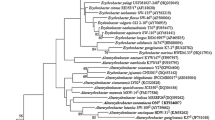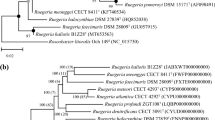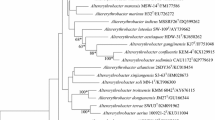Abstract
A yellow-pigmented, Gram-negative, non-flagellated, rod-shaped bacterial strain, designated M0322T, was isolated from a mudstone core sample of the Mohe Basin, China. Growth of strain M0322T was observed at 15–40 °C (optimum, 30 °C), at pH 5.0–10.0, (optimum, pH 6.0–7.0) and in the presence 0–4 % NaCl (optimum, 0 %). Phylogenetic analyses of 16S rRNA gene sequences revealed that strain M0322T formed a distinct phyletic lineage with the members of the genus Altererythrobacter and is closely related to Altererythrobacter aestuarii JCM 16339T (96.1 %) and Altererythrobacter namhicola JCM 16345T (95.7 %). The only isoprenoid quinone was identified as ubiquinone 10 (Q-10), major polar lipids were determined to be phosphatidylethanolamine, phosphatidylglycerol, phosphatidylcholine, one unidentified glycolipid and three unidentified phospholipids, while major cellular fatty acids were summed feature 8 (C18:1 ω6c and/or C18:1 ω7c), summed feature 3 (C16:1 ω6c and/or C16:1 ω7c) and 11-Methyl C18:1 ω7c. The DNA G+C content of strain M0322T was determined to be 64.6 mol%. Based on the results of the polyphasic taxonomic study, strain M0322T is considered to represent a novel species of the genus Altererythrobacter, for which the name Altererythrobacter buctense sp. nov. is proposed. The type strain is M0322T (=CGMCC 1.12871T = JCM 30112T).

Similar content being viewed by others
References
Barrow GI, Feltham RKA (eds.) (1993) Cowan and Steelham RKA (eds.) (1993) the experimental work.esearc, 3rd edn. Cambridge University Press, Cambridge
Bernardet JF, Nakagawa Y, Holmes B (2002) Proposed minimal standards for describing new taxa of the family Flavobacteriaceae and emended description of the family. Int J Syst Evol Microbiol 52:1049–1070
Colwell FS, Stormberg GJ, Phelps TJ, Birnbaum SA, McKinley J, Rawson SA, Veverka C, Goodwin S, Long PE, Russell BF, Garland T, Thompson D, Skinner P, Grover S (1992) Innovative techniques for collection of saturated and unsaturated subsurface basalts and sediments for microbiological characterisation. J Microbiol Methods 15:279–292
Felsenstein J (1985) Confidence limits on phylogenies: an approach using the bootstrap. Evolution 39:783–791
Fitch WM (1971) Toward defining the course of evolution: minimum change for a specific tree topology. Syst Zool 20:406–416
Gerhardt P (1994) Methods for general and molecular bacteriology. American Society for Microbiology, Washington DC
Gich F, Overmann J (2006) Sandarakinorhabdus limnophila gen. nov., sp. nov., a novel bacteriochlorophyll a-containing, obligately aerobic bacterium isolated from freshwater lakes. Int J Syst Evol Microbiol 56:847–854
Huang F, Zhang Y, Zhu Y, Wang P, Lu J, Lv J (2014) Flavobacterium qiangtangensis sp. nov., isolated from Qiangtang basin in Qinghai-Tibetan plateau, China. Curr Microbiol 69:234–239
Kim OS, Cho YJ, Lee K, Yoon SH, Kim M, Na H, Park SC, Jeon YS, Lee JH, Yi H, Won S, Chun J (2012) Introducing EzTaxon-e: a prokaryotic 16S rRNA gene sequence database with phylotypes that represent uncultured species. Int J Syst Evol Microbiol 62:716–721
Kimura M (1980) A simple method for estimating evolutionary rates of base substitutions through comparative studies of nucleotide sequences. J Mol Evol 16:111–120
Kishino H, Hasegawa M (1989) Evaluation of the maximum likelihood estimate of the evolutionary tree topologies from DNA sequence data, and the branching order in hominoidea. J Mol Evol 29:170–179
Kwon KK, Woo JH, Yang SH, Kang JH, Kang SG, Kim SJ, Sato T, Kato C et al (2007) Altererythrobacter epoxidivorans gen. nov., sp. nov., an epoxide hydrolase-active, mesophilic marine bacterium isolated from cold-seep sediment, and reclassification of Erythrobacter luteolus Yoon et al. 2005 as Altererythrobacter luteolus comb. nov. Int J Syst Evol Microbiol 57:2207–2211
Lee KB, Liu CT, Anzai Y, Kim H, Aono T, Oyaizu H (2005) The hierarchical system of the ‘Alphaproteobacteria’: description of Hyphomonadaceae fam. nov., Xanthobacteraceae fam. nov. and Erythrobacteraceae fam. nov. Int J Syst Evol Microbiol 55:1907–1919
Ludwig W, Strunk O, Westram R, Richter L, Meier H, Yadhukumar Buchner A, Lai T, Steppi S et al (2004) ARB: a software environment for sequence data. Nucleic Acids Res 32:1363–1371
Minnikin DE, O’Donnell AG, Goodfellow M, Alderson G, Athalye M, Schaal A, Parlett JH (1984) An integrated procedure for the extraction of bacterial isoprenoid quinones and polar lipids. J Microbiol Methods 2:233–241
Park SC, Baik KS, Choe HN, Lim CH, Kim HJ, Ka JO, Seong CN (2011) Altererythrobacter namhicola sp. nov. and Altererythrobacter aestuarii sp. nov., isolated from seawater. Int J Syst Evol Microbiol 61:709–715
Saitou N, Nei M (1987) The neighbor-joining method: a new method for reconstructing phylogenetic trees. Mol Biol Evol 4:406–425
Sasser M (1990) Identification of bacteria by gas chromatography of cellular fatty acids, MIDI Technical Note 101. MIDI Inc, Newark
Tamura K, Peterson D, Peterson N, Stecher G, Nei M, Kumar S (2011) MEGA5: molecular evolutionary genetics analysis using maximum likelihood, evolutionary distance, and maximum parsimonymethods. Mol Biol Evol 28:2731–2739
Yarza P, Richter M, Peplies J, Euzeby J, Amann R, Schleifer KH, Ludwig W, Gllecular E, Rosselló-Móra R (2008) The all-species living tree project: a 16S rRNA-based phylogenetic tree of all sequenced type strains. Syst Appl Microbiol 31:241–250
Yuan X, Nogi Y, Tan X, Zhang RG, Lv J (2014) Arenimonas maotaiensis sp. nov., isolated from fresh water. Int J Syst Evol Microbiol 64:3994–4000
Zhang RG, Tan X, Zhao XM, Deng J, Lv J (2014) Moheibacter sediminis gen. nov., sp. nov., a novel member of the family Flavobacteriaceae, isolated from the sediment, and emended descriptions of Empedobacter brevis, Wautersiella falsenii and Weeksella virosa. Int J Syst Evol Microbiol 64:1481–1487
Acknowledgments
This work was supported by grants from the National Special Research Fund of China (Gas Hydrate Resource Exploration and Production Testing Project. Grant No. GZHL20110317). We thank L. Han, L. Jia and X.M. Feng for their assistance in the experimental work.
Author information
Authors and Affiliations
Corresponding author
Electronic supplementary material
Below is the link to the electronic supplementary material.
Rights and permissions
About this article
Cite this article
Zhang, W., Yuan, X., Feng, Q. et al. Altererythrobacter buctense sp. nov., isolated from mudstone core. Antonie van Leeuwenhoek 109, 793–799 (2016). https://doi.org/10.1007/s10482-016-0679-4
Received:
Accepted:
Published:
Issue Date:
DOI: https://doi.org/10.1007/s10482-016-0679-4




